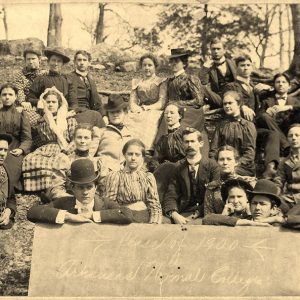calsfoundation@cals.org
Arkansas Normal College
Arkansas Normal College, located in Jamestown (Independence County), was founded in 1895 as a two-year coeducational college with a curriculum designed to prepare students to pass county teacher certification requirements. At one time, the college boasted a greater enrollment than Arkansas College (now Lyon College) in Batesville (Independence County).
In 1890, through the efforts of Dr. M. C. Weaver, A. J. Craig, W. B. Pate, and G. C. Rutledge, a high school was founded in Jamestown. Approximately five years later, after the state approved the creation of county normal (teachers’ training) schools, the two-year Arkansas Normal College was founded. While the school was chiefly designed for teacher preparation, students could also pursue traditional degrees in medicine, law, and general education.
Students from as far away as New York and North Dakota were attracted to the school, and at one time eleven states were represented in the enrollment. In 1900, the school was housed in a two-story frame building consisting of two rooms on each floor. Capacity for the building was up to 300 students.
Students were boarded in private homes at a cost of $8 a month, and tuition was $8 a term. The school catalog for 1900 estimated that yearly expenses for a student were $8 to $120. To encourage enrollment, the school paid for a fifty-mile train ticket after payment of tuition for one term.
School standards were strict, with no outside parties allowed. On occasion, chaperoned picnics and parties were allowed. Many students participated in two unusual clubs, the Our Secret Union (OSU) and the Do U Know (DUK). The clubs were founded when a male student was attempting to rekindle a relationship with a female student. After shunning him, the female students formed the DUK and made a pact to not date any of the male students. The OSU, in turn, was formed by the male students in an attempt to resolve the conflict. The only rule of the OSU was that dating was forbidden until resolution, with any violation resulting in the offending male student being dunked three times in Jamestown Creek. The impasse was resolved, and both clubs were disbanded when an offending male student punished himself by dunking.
The college cornet band, after winning several competitions, boasted that it was the best in the state. The band had its own U-shaped band wagon that was used in local parades. The band was a frequent attraction at local picnics and gatherings.
The school was directed by four presidents, the last being J. L. Graham at the turn of the twentieth century; he also served as college treasurer at the same time. Graham’s questionable conduct resulted in the downfall of the school. It was discovered that Graham was selling diplomas through the school’s correspondence department. When the state educational board learned of his activities, the board rescinded the charter of the school. Classes continued for a short time, but the lack of accreditation resulted in its closure about 1901.
A few years after the closing of the college, a fire destroyed much of the town. The town never fully recovered from these two devastating events and began a sharp decline.
For additional information:
Buchanan, Betty. “Jamestown at Turn of the Century.” Independence County Chronicle 1 (January 1960): 23–28.
Clements, Kathy. “Jamestown Once Boasted a College but Lost It because It Was Giving Unearned Diplomas.” Arkansas Democrat-Gazette, Three Rivers Section, November 22, 2000, p. 6S.
Compton, LaNell. “Life in an Ozark Village.” Arkansas Gazette Magazine, February 15, 1942, pp. 1, 12.
Mike Polston
CALS Encyclopedia of Arkansas
 Post-Reconstruction through the Gilded Age, 1875 through 1900
Post-Reconstruction through the Gilded Age, 1875 through 1900 ANC Class of 1900
ANC Class of 1900 




My grandfather, John Erven Kemper, was in the class of 1900.